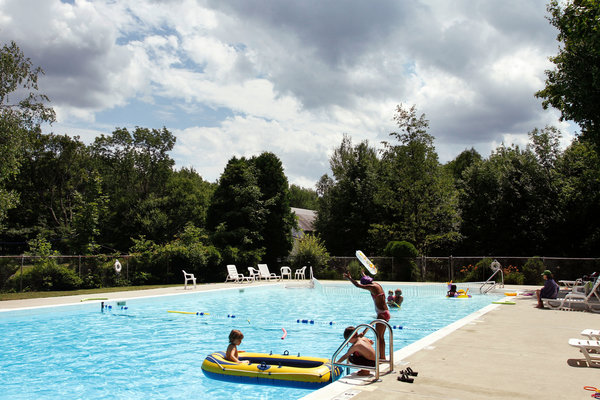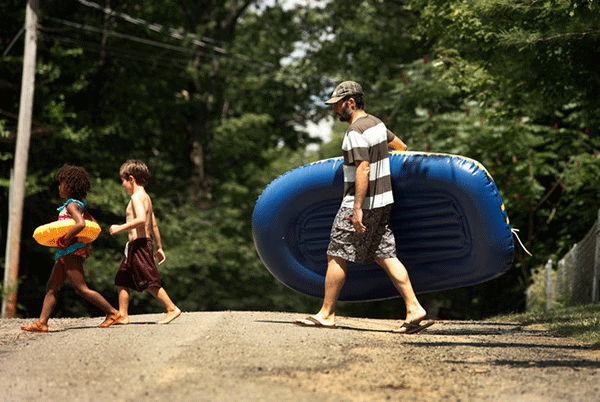In Catskills, City Buyers Recolonize Bungalows
August 4, 2013

Niko J. Kallianiotis for The New York Times |
|
The Buffalo Colony pool in Woodbourne, N.Y. |
By LISA SELIN DAVIS
Zoe Schneider was on the hunt for an affordable country house when her brother forwarded an ad to her from his Boerum Hill Listserv: a little place in the Catskills with a pool, basketball court and a playground. The price: $25,000.
“We didn’t understand why the price was so low,” said Ms. Schneider, a children’s clothing designer from Harlem. Then she saw it: a 400-square-foot semi-attached cabin, set among 21 other units in a former Catskills bungalow colony, now a co-op, called Spring Glen Woods. “I didn’t even know bungalow colonies still existed,” Ms. Schneider said. “We put an offer on it five days later.”
 |
Niko J. Kallianiotis for The New York Times |
| Easy living at the Buffalo bungalow colony in Woodbourne, N.Y. |
Bungalow colonies became a part of lower- and middle-class Jewish life at the turn of the last century, when Jewish farmers in Orange, Ulster and Sullivan Counties began renting rooms, and then cottages, to boarders. As these expanded into full-blown developments, each one owned and operated by a single family, bungalow colonies began to offer resort-like amenities — tennis courts, pools, communal buildings called casinos, featuring Saturday evening entertainment — in an enclave of humble, close-knit cottages, some renting for as little as a few dollars a week.
Eventually the area became known as the Jewish Alps, with as many as 500 bungalow colonies dotting the landscape at midcentury, the heyday of the borscht belt, according to Phil Brown of the Catskills Institute, which promotes research and education on Catskills history. As Jews assimilated and global travel expanded in the 1970s, this part of the Catskills descended into economic decline, and colonies were either taken over by Orthodox sects or abandoned; today their architectural carcasses litter the landscape.
But about a dozen former bungalow colonies became co-ops, and have attracted a new crowd: Teachers and writers, carpenters and artists, many from the city’s brownstone precincts, who are, in effect, recolonizing the colonies. Allison Pennell, a writer from Park Slope, Brooklyn, bought a unit at the Lake Huntington Summer Community, once Sharon’s Bungalow Colony, in Lake Huntington, N.Y., in 2006. She describes it as “The Park Slope Food Co-op moves upstate.” (A founding member of the Food Co-op is, in fact, a resident.)
Few colonies list their co-ops with brokers, and many of the newer residents are drawn there by contacts from within the city. Ronda Matthews, a teacher from Park Slope, was invited to Buffalo Colony, in Woodbourne, N.Y., last year by the parents of her daughter’s classmate at Public School 321, who knew she was searching for an affordable second home upstate.
After one night at the outpost of 30 units, which are arrayed around a U-shaped meadow, with a pool, and mountain views, she was ready to buy. “It’s like a drug,” she said. “Once you try it, you’re hooked.” She bought a three-bedroom unit last year.
Perhaps most addictive is what parents call the “beautiful freedom” that colonies allow, for both parents and children. “You don’t need to set up play dates here,” said Rebecca Ballantine, a teacher from Bedford-Stuyvesant, Brooklyn, and a mother of five, who also bought a three-bedroom unit at Buffalo Colony last year. “Your kids just walk outside.”
Best, say parents: They entertain themselves, and one another, all day long.
“I get up in the morning and make my daughter an egg sandwich and I see her at the end of the day,” said Ms. Pennell’s husband, Mark Pennell, whose daughter, Aidy, is 10. Parents feed whichever children show up at their bungalow come noon. “There’s a lot of mac and cheese,” said Alise Loebelsohn, a mural painter from Park Slope who bought a two-bedroom unit at Lake Huntington in 2010.
If anyone is eating heirloom vegetables, they brought them from home. Fancy markets are a rarity in this neck of the woods; Sullivan County has the fourth highest rate of poverty in New York State, and specialty foods in markets tend to be kosher, catering to the Orthodox crowd. There are few televisions, and Internet and cellphone service can be limited. In most colonies, kitchens are diminutive, there are no granite countertops, and an entire unit might be smaller than a resident’s apartment back home. At every colony residents uttered a similar refrain: The Hamptons, it’s not.
“One of the first questions people ask is, ‘Is there air-conditioning?’ and that separates people out,” Ms. Loebelsohn said. (There is not.) “You’ll know in the first few seconds if you like it or not.”
Each colony has its own personality. At the woodsy and quiet Buffalo Colony, which has much larger, family-size units, there are gay and straight parents, and biological and adopted children of many races. Lansman’s, an 85-unit colony in Woodbourne, which was bought by former renters from back in its family-owned days, is still mostly Jewish. Stephanie Kreiner, president of the board there, said residents still play mah-jongg and attend Saturday evening entertainment in the casino. Spring Glen Woods, in Ellenville, N.Y., has residents from New Jersey, Manhattan, the Bronx and Queens. “We want to bring it back to its heyday,” Ms. Schneider said.
Seven new families have moved in to Spring Glen Woods since 2009, five of them recruited by Ms. Schneider. At Buffalo Colony, five new families arrived last year. Eight of Lake Huntington’s 55 units have sold in the last five years, and it also offers short-term rentals, which bring in new parties all summer long.
The sales prices — generally $15,000 to $75,000, though larger units at Buffalo Colony can top $100,000 — are especially alluring. While real estate in gentrified Brooklyn regularly commands $700 per square foot, places like Lansman’s can charge as little as $10. “New York has felt like it’s only for rich people lately,” said Ms. Ballantine, of Buffalo Colony. “This really feels like a place for the middle class.”
Though far less expensive than free-standing country houses, most bungalows are seasonal homes, and thus ineligible for mortgages; they must be paid for in cash, and there are supplemental yearly fees, dependent on the number of shares. Bungalows do not tend to appreciate much in value. “We didn’t buy it as an investment, and don’t expect we’ll make money on it,” says Jim Moske, an archivist from Riverdale who bought a unit at Spring Glen Woods in 2009.
The new colonists say they are welcomed by the old-timers and describe the ease of colony life. “We have a pool that we don’t have to clean and a lawn that we don’t have to mow,” Ms. Matthews said. The original dream may have been to restore a ramshackle farmhouse, but this life, they have found, is far simpler. “We don’t come up to the country to do chores,” Mr. Pennell said.
These are cooperatives, though, with their all-too-familiar board meetings and group decisions. Dishwashers and private washing machines are usually outlawed — the electric grid couldn’t handle it, even if residents wanted to modernize, and they don’t. At Spring Glen Woods, visiting friends can’t sleep in the casino or camp out on the lawn. At Lake Huntington, all buildings must be painted white (you can choose the trim color), and adding a deck may increase your annual fee. Don’t ask Lake Huntington residents about adding a dog run unless you’ve got a few hours to spare.
“We have people with a lot of strong opinions,” Ms. Loebelsohn said. “But that’s what makes it interesting.” Solitude is hard to come by, and it may feel strange to repair to the country with your neighbors from back home, to visit the city in the woods. But accommodating the personalities among the pines is something co-op apartments and rush-hour subway rides have prepared New Yorkers for. “You deal with it,” Mr. Pennell said. “Everybody just learns to get along.”
|





